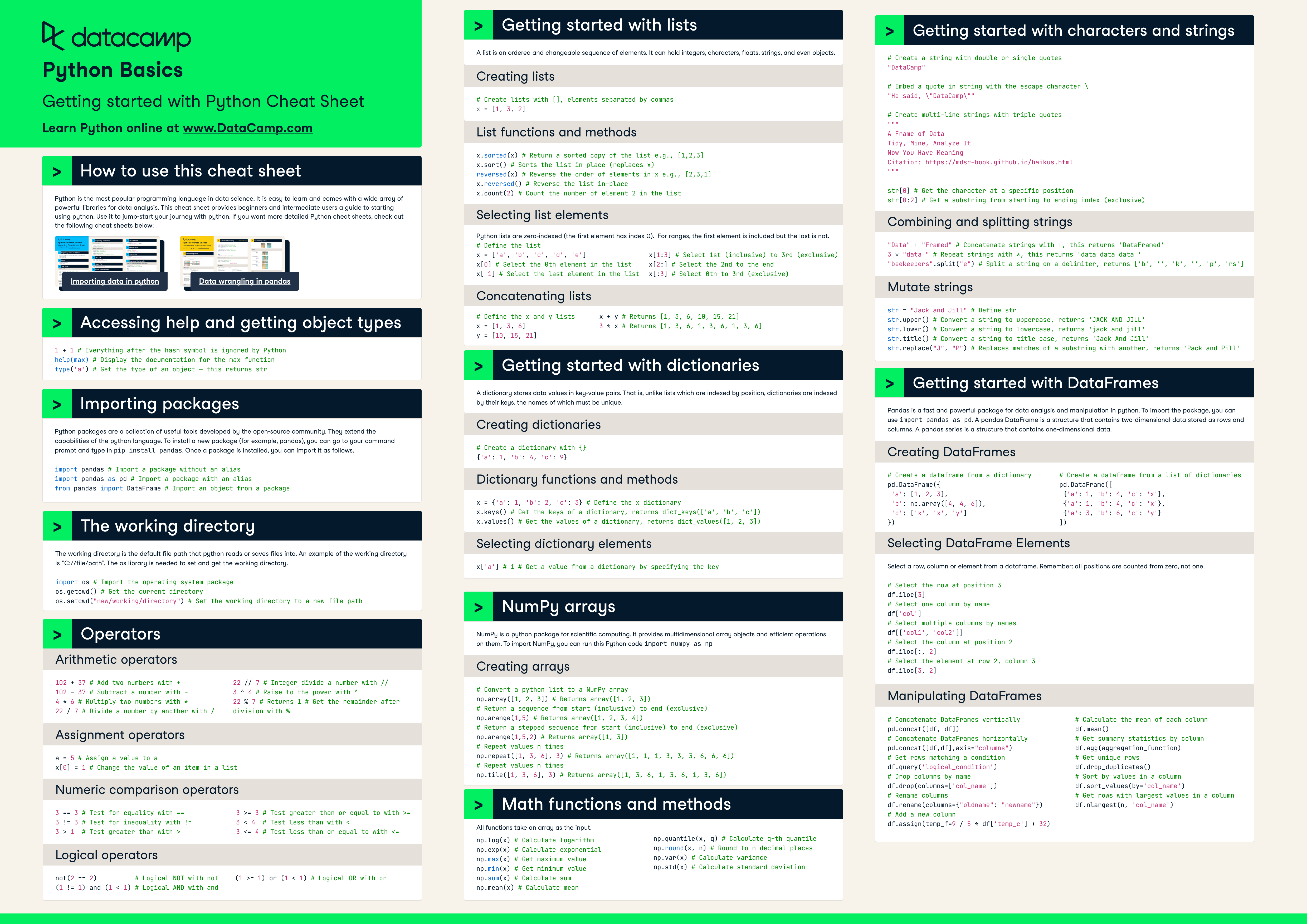Python is the most popular programming language in data science. It is easy to learn and comes with a wide array of powerful libraries for data analysis. This cheat sheet provides beginners and intermediate users a guide to using python. Use it to jump-start your journey with python. Check out other Python cheats sheets if you want more detailed guides.
Have this cheat sheet at your fingertips
Download PDFEjecute y edite el código de esta hoja de trucos en línea
Ejecutar códigoAccessing help and getting object types
1 + 1 #Everything after the hash symbol is ignored by Python
help(max) #Display the documentation for the max function
type('a') #Get the type of an object — this returns strImporting packages
Python packages are a collection of useful tools developed by the open-source community. They extend the capabilities of the python language. To install a new package (for example, pandas), you can go to your command prompt and type in pip install pandas. Once a package is installed, you can import it as follows.
import pandas # Import a package without an alias
import pandas as pd # Import a package with an alias
from pandas import DataFrame # Import an object from a packageThe working directory
The working directory is the default file path that python reads or saves files into. An example of the working directory is ”C://file/path". The os library is needed to set and get the working directory.
import os # Import the operating system package
os.getcwd() # Get the current directory
os.setcwd("new/working/directory") # Set the working directory to a new file pathOperators
Arithmetic operators
102 + 37 #Add two numbers with +
102 - 37 # Subtract a number with -
4 * 6 # Multiply two numbers with *
22 / 7 # Divide a number by another with /
22 // 7 # Integer divide a number with //
3 ** 4 # Raise to the power with **
22 % 7 # Returns 1 # Get the remainder after division with %Assignment operators
a = 5 # Assign a value to a
x[0] =1 # Change the value of an item in a listNumeric comparison operators
3 == 3 # Test for equality with ==
3 != 3 # Test for inequality with !=
3 > 1 # Test greater than with >
3 >= 3 # Test greater than or equal to with >=
3 < 4 # Test less than with <
3 <= 4 # Test less than or equal to with <=Logical operators
not (2 == 2) # Logical NOT with not
(1 != 1) and (1 < 1) # Logical AND with and
(1 >= 1) or (1 < 1) # Logical OR with orGetting started with lists
A list is an ordered and changeable sequence of elements. It can hold integers, characters, floats, strings, and even objects.
Creating lists
# Create lists with [], elements separated by commas
x = [1, 3, 2]List functions and methods
# Return a sorted copy of the list x
sorted(x) # Returns [1, 2, 3]
# Sort the list in-place (replaces x)
x.sort() # Returns None
# Reverse the order of elements in x
reversed(x) # Returns [2, 3, 1]
# Reverse the list in-place
x.reversed() # Returns None
# Count the number of element 2 in the list
x.count(2)Selecting list elements
Python lists are zero-indexed (the first element has index 0). For ranges, the first element is included, but the last is not.
# Define the list
x = ['a', 'b', 'c', 'd', 'e']
# Select the 0th element in the list
x[0] # 'a'
# Select the last element in the list
x[-1] # 'e'
# Select 1st (inclusive) to 3rd (exclusive)
x[1:3] # ['b', 'c']
# Select the 2nd to the end
x[2:] # ['c', 'd', 'e']
# Select 0th to 3rd (exclusive)
x[:3] # ['a', 'b', 'c']Concatenating lists
# Define the list x and y
x = [1, 3, 6]
y = [10, 15, 21]
# Concatenate lists with +
x + y # [1, 3, 6, 10, 15, 21]
# Repeat list n times with *
3 * x # [1, 3, 6, 1, 3, 6, 1, 3, 6]Getting started with dictionaries
A dictionary stores data values in key-value pairs. That is, unlike lists indexed by position, dictionaries are indexed by their keys, the names of which must be unique.
Creating dictionaries
# Create a dictionary with {}
{'a': 1, 'b': 4, 'c': 9}Dictionary functions and methods
# Define the dictionary
a = {'a': 1, 'b': 2, 'c': 3}
# Get the keys
x.keys() # dict_keys(['a', 'b', 'c'])
# Get the values
x.values() # dict_values([1, 2, 3])
# Get a value from a dictionary by specifying the key
x['a'] # 1NumPy arrays
NumPy is a python package for scientific computing. It provides a multidimensional array of objects and efficient operations on them. To import NumPy, you can run this Python code import numpy as np
Creating arrays
# Convert a python list to a NumPy array
np.array([1, 2, 3]) # array([1, 2, 3])
# Return a sequence from start (inclusive) to end (exclusive)
np.arange(1,5) # array([1, 2, 3, 4])
# Return a stepped sequence from start (inclusive) to end (exclusive)
np.arange(1,5,2) # array([1, 3])
# Repeat values n times
np.repeat([1, 3, 6], 3) # array([1, 1, 1, 3, 3, 3, 6, 6, 6])
# Repeat values n times
np.tile([1, 3, 6], 3) # array([1, 3, 6, 1, 3, 6, 1, 3, 6])Math functions and methods
# Calculate logarithm of an array
np.log(x)
# Calculate exponential of an array
np.exp(x)
# Get maximum value of an array
np.max(x)
# Get minimum value of an array
np.min(x)
# Calculate sum of an array
np.sum(x)
# Calculate mean of an array
np.mean(x)
# Calculate q-th quantile of an array x
np.quantile(x, q)
# Round an array to n decimal places
np.round(x, n)
# Calculate variance of an array
np.var(x)
# Calculate standard deviation of an array
np.std(x) Getting started with characters and strings
# Create a string variable with single or double quotes
"DataCamp"
# Embed a quote in string with the escape character \
"He said, \"DataCamp\""
# Create multi-line strings with triple quotes
"""
A Frame of Data
Tidy, Mine, Analyze It
Now You Have Meaning
Citation: https://mdsr-book.github.io/haikus.html
"""
# Get the character at a specific position
str[0]
# Get a substring from starting to ending index (exclusive)
str[0:2]Combining and splitting strings
# Concatenate strings with +
"Data" + "Framed" # 'DataFramed'
# Repeat strings with *
3 * "data " # 'data data data '
# Split a string on a delimiter
"beekeepers".split("e") # ['b', '', 'k', '', 'p', 'rs']Mutate strings
# Create a string named str
str = "Jack and Jill"
# Convert a string to uppercase
str.upper() # 'JACK AND JILL'
# Convert a string to lowercase
str.lower() # 'jack and jill'
# Convert a string to title case
str.title() # 'Jack And Jill'
# Replaces matches of a substring with another
str.replace("J", "P") # 'Pack and Pill'Getting started with DataFrames
pandas is a fast and powerful package for data analysis and manipulation in python. To import the package, you can use import pandas as pd. A pandas DataFrame is a structure that contains two-dimensional data stored as rows and columns. A pandas series is a structure that contains one-dimensional data.
Creating DataFrames
# Create a dataframe from a dictionary
pd.DataFrame({
'a': [1, 2, 3],
'b': np.array([4, 4, 6]),
'c': ['x', 'x', 'y']
})
# Create a dataframe from a list of dictionaries
pd.DataFrame([
{'a': 1, 'b': 4, 'c': 'x'},
{'a': 1, 'b': 4, 'c': 'x'},
{'a': 3, 'b': 6, 'c': 'y'}
])Selecting DataFrame Elements
Here are the different ways to select a row, column or element from a dataframe.
# Select the row at position 3
df.iloc[3]
# Select one column by name
df['col']
# Select multiple columns by names
df[['col1', 'col2']]
# Select the column at position 2
df.iloc[:, 2]
# Select the element at row 2, column 3
df.iloc[3, 2]Manipulating DataFrames
# Concatenate DataFrames vertically
pd.concat([df, df])
# Concatenate DataFrames horizontally
pd.concat([df,df],axis="columns")
# Get rows matching a condition
df.query('logical_condition')
# Drop columns by name
df.drop(columns=['col_name'])
# Rename columns
df.rename(columns={"oldname": "newname"})
# Add a new column
df.assign(temp_f=9 / 5 * df['temp_c'] + 32)
# Calculate the mean of each column
df.mean()
# Get summary statistics by column
df.agg(aggregation_function)
# Get unique rows
df.drop_duplicates()
# Sort by values in a column in ascending order
df.sort_values(by='col_name')
# Get the rows with the n largest values of a column
df.nlargest(n, 'col_name')
